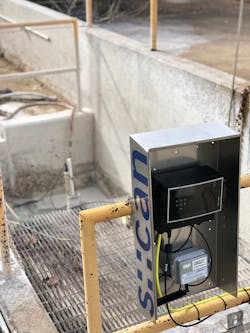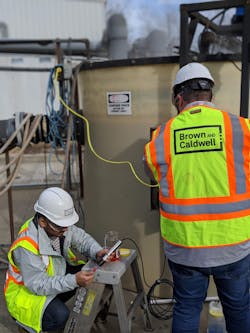Digital Solutions Enhance Source Control in Memphis
In June 2018, the Stiles Wastewater Treatment Facility (WWTF) located in Memphis, Tenn., experienced an abnormal event where the influent pH exceeded historic levels. The maximum pH measured for that day was greater than 11.5 standard units. The Stiles operations staff immediately notified the city’s Industrial Monitoring and Pretreatment Program, which sent four crews into the field to collect and analyze grab samples from their 10 largest significant industrial users (SIUs) for pH, and to confirm the calibration of the industrial pH sensors.
Based on the samples, the record influent pH was attributed to three major SIUs discharging wastewater with high pH, one of which was discharging higher than its permit limit. While the city’s operations staff made operational changes to ensure no National Pollutant Discharge Elimination System (NPDES) permit violation occurred, this toxic condition killed a substantial portion of the WWTF biomass, which took over a week to recover.
This was not the first time a scenario like this occurred, however this was a defining point for the City of Memphis Division of Public Works and its Industrial Monitoring and Pretreatment Program. The city decided that there must be a better solution for monitoring industry.
“The traditional way of monitoring really doesn’t tell the whole picture,” Tasha King-Davis, City of Memphis administrator of environmental compliance and permitting, said, referring to the 24-hour composite and grab sampling procedures. This captures only a snapshot of the industrial discharge for that day and does not show spikes in discharge water quality which may impact operations of the collection system and the WWTF, she said.
In late 2018, the city decided to pilot a new digital solution developed by Brown and Caldwell to take control of water quality monitoring issues. The digital solution included a smart sensor network where water quality monitoring stations were installed directly at permitted discharge points for five of the largest industrial users. The smart sensors provided measurement of pH, biochemical oxygen demand (BOD), total suspended solids (TSS), chemical oxygen demand (COD), nutrient compounds, and a spectral fingerprint using UV absorbance over a wavelength range of 200-800 nanometers (nm). These data points were transmitted via cellular network to a cloud-based server for visualization in near real-time.
“Having real time data is a game changer,” Scott Morgan, senior environmental administrator with the city of Memphis, said. “It allows staff to see what is being discharged and provides time to react if it is something that will affect the system. This is a great tool to protect our employees’ health and safety and to help ensure we maintain a healthy biomass and the treatment facility.”
For example, one holiday weekend during the pilot test, a slug discharge occurred at one of the SIUs where sensors were installed. The smart sensor network notified city staff, who then had adequate time to make any necessary changes in operations prior to the slug discharge reaching the treatment facility.
The pilot project served many purposes and was a proof of concept project for the city to determine the feasibility of the paradigm shift to digital water quality monitoring solutions.
“Digital solutions have allowed the City to enhance oversight of industrial discharges without the need to increase staffing. Instead of having to send staff to the industries to check for pH, remote monitoring continuously sends pH data to our fingertips,” King-Davis said.
The successful pilot project opened the city’s eyes to a whole new world of possibilities for enhanced source control.
“The City’s Public Works Division has a vision of being a smart city and wants to be a leader in how a public utility can maximize the use and application of smart technologies,” Director of public works Robert Knecht said.
Today, the city of Memphis and the Brown and Caldwell team are in the second phase of the project, where 12 smart sensor water quality stations were installed at ten of the largest SIUs and at the two WWTFs. To address corrosion in the collection system and the pH swings at the WWTFs, this phase of the project is focused solely on measuring and reporting pH in near real-time, using Internet of Things (IoT) technologies. The data are being transmitted to a cloud-based platform where the Brown and Caldwell team ingests data and has automated data visualization. During the pilot, the City recognized that having individual logins for each monitoring station to view data was cumbersome, so Brown and Caldwell developed a solution to mitigate this issue. All data are combined into one data viewer with the capability of filtering for individual SIUs, dates, and other parameters. Data is converted to information using graphs, charts, percentages of noncompliance, and other performance metrics to give the City more than just a snapshot of each industrial discharge.
In addition to the smart sensor network deployed throughout the city, Brown and Caldwell is developing a treatment plant operations dashboard to consolidate numerous data sources into a unified platform. This will allow data trending for influent and effluent at the treatment facilities, energy use from supervisory control and data acquisition (SCADA) systems, industrial loadings from the pretreatment program database, laboratory data from the laboratory information management system (LIMS) and other operational and performance data.
This is just the beginning for the City of Memphis in becoming a smart utility. Knecht envisions that “there are many long-term benefits to utilities who utilize new digital based opportunities such as artificial intelligence, machine/deep learning, smart analytics, and smart technologies ... The greatest long-term benefit toward being a smart utility is cost savings. With long-term utilization, smart technologies will reduce O&M cost and identify capital funding needs much more strategically. These savings will ultimately benefit the utility’s customers who pay for the cost of the services provided.” WW
About the Authors: John Abrera is the national integrated digital applications lead for Brown and Caldwell. During his career, he has focused on improving Information Technologies for local utilities, such as data platforms, predictive analytics and IoT.
Joshua Balentine is the pretreatment program technical lead for Brown and Caldwell. He has worked as a pretreatment program manager for a large utility, contractor for the U.S. EPA National Pretreatment Program and numerous EPA regions, and now as a consultant to pretreatment programs.
Kati Bell is the managing director of water strategy and leads Brown and Caldwell’s Research and Development team. During her career, she has supported projects globally in wastewater treatment, disinfection, and water reuse.
About the Author
John Abrera
John Abrera is the national integrated digital applications lead for Brown and Caldwell. During his career, he has focused on improving Information Technologies for local utilities, such as data platforms, predictive analytics and IoT.
Joshua Balentine
Joshua Balentine is the pretreatment program technical lead for Brown and Caldwell. He has worked as a pretreatment program manager for a large utility, contractor for the U.S. EPA National Pretreatment Program and numerous EPA Regions, and now as a consultant to pretreatment programs.
Kati Bell
Dr. Kati Bell is the managing director of water strategy and leads Brown and Caldwell’s Research and Development team. During her career, she has supported projects globally in wastewater treatment, disinfection, and water reuse.


